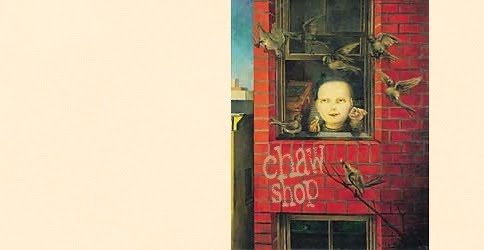I've always envied cartoonists. Not animators -- their frame-by-frame slaving sounds like a variation on that old childhood punishment of writing an apology over and over until the words become meaningful only as a carpal-tunnel ache -- but graphic novelists, comic book artists, whatever you want to call them. I loved newspaper comics as a kid, Calvin and Hobbes and the Far Side especially, as well as collections of one-panel wonders from The New Yorker magazine, the old ones by Thurber and Charles Addams. As an adult, I read comics less often than I used to; with the exception of Watchmen, I haven't tackled any of the big series in the superhero genre, and I only read a graphic novel every once in a long while. But the directness of the medium, the way it combines cinematic visual techniques with the one-on-one intimacy of an author's connection with a lone reader, still fascinates me.
A few months ago, I read Black Hole by Charles Burns. I borrowed it from a friend, consumed it almost immediately, and then hung onto it for a long time, thinking I would write a blog post about it. Obviously I never did, and this post isn't primarily about it either. But today, thinking again about my ongoing discussion about difficulty, some of the images from that book sprang to mind.
Black Hole tells the story of a group of teenagers in the 1970's, beset with a mysterious STD that turns them into freaks: a girl sheds her skin, a boy develops a tiny talking mouth on his neck, and others contract maladies even more difficult to encapsulate in words. This is pulpy, suspenseful, and compelling in itself, and if Burns relied on the bare bones of the story to carry us through, I'd probably still have kept turning the pages. However, what he does is a lot stranger.
When reading the book, I was at first inclined to think that the disease the teens suffer from is meant to represent something from our world, most likely AIDS. But by the end, I became convinced that Burns is not working metaphorically, using one set of images to stand in for another set that the reader can supply. Black Hole, instead, is about the hidden connections between images: the way an incision in a frog's belly or a cut on the sole of a foot looks like a vagina, the way a tail resembles a penis. And as the book goes on, far from becoming easier to parse, these connections multiply. Objects -- bones, pipes, sandwiches, snakes -- stream across the pages, freed from their original context; panels break out from their orderly grid. We're no longer decoding symbols. The meaning of the objects clearly can't be divorced from the particular way they're depicted.
This is something we're more inclined to accept in visual art than in narrative. Perhaps it's because of the way literature is taught: at least at the places I attended, most American schoolchildren grew up thinking that it was possible to figure out what a poem "really meant," what a story was "about," and articulate this without the work's meaning being lost, as if literature were simply a foreign language they were learning to speak. Stylistic embellishments stood as obstacles in the way to understanding, an odd regional accent that made the speaker's words tougher to translate. "What is Wallace Stevens trying to say here?" one high school teacher said of the poem "Anecdote of the Jar," facing a classroom of dead silence. He sighed, deciding to give us a break. "All right, I'll just tell you: it's about environmentalism."
Yet, with visual art, the work qua object is not so easily dispensed with. Words can describe a painting or sculpture, but even a nine-year-old knows they cannot replace it. And thus, even if the technical aspects of the artwork -- the perspective, the composition, the colors -- are perceived to be unpleasant or disagreeable, difficult, they're still treated as part of the thing we're seeing, rather than something that prevents us from seeing that thing clearly.
Perhaps, though, the popularity of graphic novels (at least sophisticated ones like Black Hole) can serve as a bridge between these opposed ways of seeing visual art and narrative. Wouldn't that be nice?


No comments:
Post a Comment